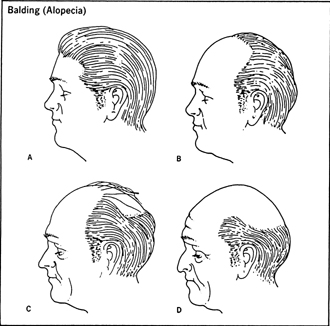Hair - General hair care
Properly cared for hair usually looks clean, shiny, and alive. Unfortunately, too many people mask the natural good looks of their hair with unnecessary sprays and “beauty” preparations.
Washing the Hair
Hair should be washed about once a week—more often if it tends to be oily. The claims made by shampoo manufacturers need not always be taken too seriously, since most shampoos contain nothing more than soap or detergent and a perfuming agent. No shampoo can restore the natural oils to the hair at the same time that it washes it. A castile shampoo is good for dry hair, and one containing tincture of green soap is good for oily hair.
Thorough rinsing is essential to eliminate any soap deposit. If the local water is hard, a detergent shampoo can be rinsed off more easily than one containing soap.
Drying the Hair
Drying the hair in sunlight or under a heat-controlled dryer is more satisfactory than trying to rub it dry with a towel. Gentle brushing during drying reactivates the natural oils that give hair its shine. Brushing in general is excellent for the appearance of the hair. Be sure to wash both brush and comb as often as the hair is washed.
Hair pomades should be avoided or used sparingly, since they are sometimes so heavy that they clog the pores of the scalp. A little bit of olive oil or baby oil can be rubbed into dry hair after shampooing. This is also good for babies' hair.
There is no scientific evidence that creme rinses, protein rinses, or beer rinses accomplish anything for the hair other than making it somewhat more manageable if it is naturally fine and flyaway.
Dandruff
Simple dandruff is a condition in which the scalp begins to itch and flake a few days after the hair has been washed. There is no evidence that the problem is related to germ infection.
Oiliness and persistent dandruff may appear not only on the scalp but also on the sides of the nose or the chest. In such cases, a dermatologist should be consulted. Both light and serious cases often respond well to prescription medicines containing tars. These preparations control the dandruff, but there is no known cure for it.
Nits
Head lice sometimes infect adults as well as children. These tiny parasites usually live on the part of the scalp near the nape of the neck, and when they bite, they cause itching. They attach their eggs, which are called nits , to the shaft of the hair, and when they are plentiful, they can be seen by a trained eye as tiny, silvery-white ovals. This condition is highly contagious and can be passed from one head to another by way of combs, brushes, hats, head scarfs, and towels. A physician can be consulted for information on effective ways of eliminating nits—usually by the application of chemicals and the use of a fine-tooth comb.
Baldness
Under the normal circumstances of combing, brushing, and shampooing, a person loses anywhere from 25 to 100 hairs a day. Because new hairs start growing each day, the loss and replacement usually balance each other. When the loss rate is greater than the replacement rate, thinning and baldness are the result.
Alopecia
The medical name for baldness is alopecia , the most common form of which is male pattern baldness . Dr. Eugene Van Scott, Professor of Dermatology of Temple University's Health Sciences Center, sums up the opinion of medical authorities on the three factors responsible for this type of baldness: sex, age, and heredity. Unfortunately, these are three factors over which medical science has no control. Two drugs have been approved for regrowing hair: minoxidil and finasteride. Minoxidil, a topical solution, is available over the counter and is sold under the brand name Rogaine and as a generic drug. Approximately 25 percent of men and 20 percent of women using it experience some hair growth. Finasteride, a pill marketed as Propecia, was approved in 1997. More than 80 percent of men in trials experienced a slowing of hair loss and 60 percent grew new hair. Propeicia is available by prescription only.
Other Causes of Baldness
Other forms of baldness may be the result of bacterial or fungal infections, allergic reactions to particular medicines, radiation, or continual friction. It has also been suggested that constant stress from hair curlers or tightly pulled ponytails can cause loss of hair. These forms of baldness usually disappear when the cause is eliminated.

Although diet has very little to do with baldness, poor nutrition can result in hair that is dry, dull, and brittle enough to break easily. Any serious illness can lead to hair loss as well. It is thought that vitamin A taken in grossly excessive amounts can contribute to hair loss.
Women ordinarily lose some of their hair at the end of pregnancy, after delivery, and during the menopause, but regrowth can be expected in a few months.
It is now possible for anyone suffering from temporary baldness or from male pattern baldness to choose from a wide variety of attractively styled wigs and hairpieces.
A surgical procedure for treating male pattern baldness and baldness in women is called hair transplantation; it is discussed in Ch. 20, Surgery .

Comment about this article, ask questions, or add new information about this topic: